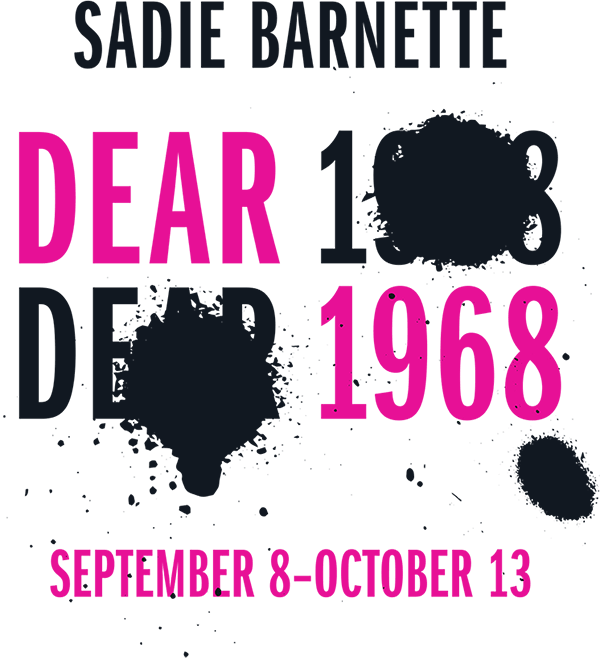Whose 1968? Bringing History Home in Sadie Barnette’s Dear 1968,…
Sampada Aranke
Dear 1968,… is Sadie Barnette’s love letter to the movement, a letter addressed to a year of profound global revolutionary impact.1 In the U.S., youth-led social movements were in full force, the most notable being the Black Panther Party for Self Defense (BPP) which was founded in Oakland, California in 1966. The BPP called for a full scale revolution in the U.S. in order to eradicate capitalism, racism, sexism, and homophobia as part of the full realization of Black liberation. In September 1968, FBI director J. Edgar Hoover had designated the BPP as “the most dangerous threat to the internal security of the country.”2 The year 1968 connects these historical events with Barnette’s own genealogy—this is when her father, Rodney Barnette, founded the Compton chapter of the BPP. It’s a year that sets the stage for Sadie’s life, as it does for her work, which recomposes what constitutes the personal and political, private and public, and familial and bureaucratic.
These are the intimate ties that bind in Sadie Barnette’s work. She balances the cold bureaucracy of government surveillance with the interpersonal closeness of family. Her main source material for Dear 1968,… is her father’s 500-page FBI file, which her family successfully secured after filing a Freedom of Information Act request. The FBI’s surveillance of Rodney Barnette’s everyday activities was comprehensive to say the least. It included a steady team of special agents who conducted routine surveillance, harassed people close to Barnette, and attempted to frame him with charges of illegal activities by soliciting informants to infiltrate the BPP.3 In Dear 1968,… Sadie mobilizes the FBI documents, either by mounting select rhinestone–adorned and graffiti–marked pages of these documents on glowing pink Plexiglas, or by arranging parts of the file into a wallpaper print. In this way, Barnette intervenes in their presumed authority. Hers is a black radical aesthetic that demonstrates how these files tarry between private and public, domestic wallpaper and a wheat-paste poster, family album and FBI file, a cherished photograph and police mugshot.
Dear 1968,… asks us to reconceptualize the personal and political. Barnette isolates and arranges a selection of official stamps that mark various pages of the FBI file to make a composition of her own, which she then adheres onto the gallery wall to evoke the thin line between wheat-paste and wallpaper. One can only imagine the bureaucrat’s hand that stamped these documents—and thousands of others—as an act of quotidian labor, marking the endless shuffle of papers in and out of FBI field offices all over the nation. This wallpaper becomes the backdrop for family photos, an indication of how these files—and what they represent more broadly—literally stage, if not structure, Barnette’s family history.
This history is evidenced by Untitled (Dad 1966 and 1968), two large-scale photographs of Rodney Barnette in two different kinds of uniforms. In one photo is Barnette as a young man, dressed in his Army regalia after being drafted for war, and in the other, he’s in full Black Panther uniform. The two photographs offer points of personal contact and departure—one Barnette unwillingly fights for U.S. imperial interests in Vietnam and the other fights against racism at home. These portraits map a terrain where Rodney’s public service presents an uncanny and unanticipated critique of his nation, a nation that would ultimately turn against him once he dedicated his life to the Black liberation movement.

Custom wall vinyl, installation dimensions variable.
© Sadie Barnette. Courtesy of the artist.
These are not the only family photos present in Dear 1968,… Sadie includes another wallpapered panel, this time a composition of a young Black child seated on a wicker chair in the style made famous by that now-iconic image of the Panther leader Huey Newton with a gun in one hand and a spear in the other.4 But in this polaroid, Barnette shields the child’s face from view with a delicately applied neon chevron game piece, offering up a colorful embellishment as a mode of protection. Here, the public image of the radical Black subject is literally brought home, the wicker chair locating both public and private histories in living rooms in Black homes nationwide from the 1960s on. Barnette reminds us, after all, that Newton’s image itself looks like a domestic space, the comforts of which make the political, personal and the public, private.
Ultimately, Barnette’s main mode of critique is her operative uses of color itself, deployed with a radiant attention that captivates. The FBI documents have no grey area—chromatically and metaphorically.5. She interrupts the files with glitter embellishments, neon spray, and neon glows. Barnette deploys color as a kind of adornment, even celebration, thus enlivening an intimacy that formally exceeds the chromatic, social, and political structures of black and white.6 These pops of color and shine attempt to bring life to the cold FBI data, making room for the artist to talk back to the dichotomies that color her family and life, and by extension the movement.
Barnette transforms the proper place of the political in the living room, where private space is deeply public, an adorned site of familial pleasure. It’s in the living room that these portraits of her father take on new meaning—they become activations of 1968 and beyond, a historical activation on intimate terms. This historic year is made deeply personal, saturated within the contrast of black and white with the promising interruptions of pinks and glitter. It’s from within Sadie’s version of 1968 that she signs her love letter: Love, 1984.
Sampada Aranke (PhD, Performance Studies) is an Assistant Professor in the Art History, Theory, Criticism Department at the School of the Art Institute, Chicago. Her research interests include performance theories of embodiment, art history and visual culture, and black cultural and aesthetic theory. Her work has been published in e-flux, Art Journal, Artforum, Equid Novi: African Journalism Studies, and Trans-Scripts: An Interdisciplinary Online Journal in the Humanities and Social Sciences at UC Irvine. Sampada and Nikolas Oscar Sparks (Duke University) have co-edited a special issue of Women & Performance entitled “Sentiment and Sentience: Black Performance Since Scenes of Subjection” (April 2017). She’s currently working on her book manuscript entitled Death’s Futurity: The Visual Culture of Death in Black Radical Politics.
Footnotes:
- George Katsiaficas, The Imagination of the New Left: A Global Analysis of 1968 (Boston: South End Press, 1987).↑
- Ward Churchill and James Vanderwall, Agents of Repression: The FBI’s Secret Wars against the Black Panther Party and the American Indian Movement (Boston: Southend Press, 2008); Gabriel San Roman, “1969: The Year the Black Panther Party Was to Be Annihilated,” Truthout, January 28, 2014, accessed February 27, 2017, http://www.truth-out.org/news/item/21382-1969-the-year-the-black-panther-party-was-to-be-annihilated.↑
- Rodney and Sadie Barnette, “A Panther’s Story Becomes Art: A Conversation Between Artist Sadie Barnette and her Father and Former Black Panther Rodney Barnette,” Oakland Museum of California blog, November 4, 2016, http://museumca.org/blog/panthers-story-becomes-art ↑
- Jo-Ann Morgan, “Huey P. Newton Enthroned—Iconic Image of Black Power,” The Journal of American Culture, 37 (2) (2014): 129-148.↑
- Elsewhere, I’ve talked about Barnette’s uses of black and white as tied to the histories that align Blackness with abstraction. Sampada Aranke, “Material Matters: Radical Black Aesthetics and the Limits of Visibility,” e-flux journal, no. 79 (February 2017), accessed 27 February 2017. http://www.e-flux.com/journal/79/94433/material-matters-black-radical-aesthetics-and-the-limits-of-visibility/ ↑
- Sadie Barnette’s work is indeed an extension of Zora Neale Hurston’s notion of “the will to adorn” as a “notable characteristic” of black American literary aesthetics. Zora Neale Hurston, “Characteristics of Negro Expression,” 1934. Reprinted in The Gender of Modernism: A Critical Anthology, ed. Bonnie Kime Scott (Bloomington: Indiana University Press, 1990), 176, 178.↑

